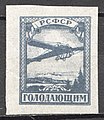
This a survey of the postage stamps and postal history of the Russian Empire, the Soviet Union and the modern Russian Federation.

The Far Eastern Republic, sometimes called the Chita Republic, existed from April 1920 to November 1922 in the easternmost part of Siberia. It was formed from the Amur, Transbaikal, Kamchatka, Sakhalin, and Primorye regions. In theory, it extended from Lake Baikal to Vladivostok but, in May 1921, the Priamur and Maritime Provinces seceded. Although nominally independent, it was largely controlled by the RSFSR and its main purpose was to be a democratic buffer state between the RSFSR and the territories occupied by Japan during the Russian Civil War to avoid war with Japan. Initially, its capital was Verkhneudinsk, but from October 1920 it was Chita. On 15 November 1922, after the war ended and the Japanese withdrew from Vladivostok, the Far Eastern Republic was annexed by Soviet Russia.

Giovanni (Jean) de Sperati was an Italian stamp forger. Robson Lowe considered him an artist and even professional stamp authenticators of his time attested to the genuineness of his work. Sperati created what he called a Livre d'Or which he boasted of in his autobiography and which contained 239 favourable opinions as to the genuineness of his forgeries from numerous experts, including Dr. Edward Diena and the Royal Philatelic Society London.

The Mexican postal system has its roots in the Aztec system of messengers which the Spanish adopted after the Conquest. A postal service was established in 1580, mainly to communicate between the viceroyalty of New Spain with the motherland Spain. During the 18th century, Spain established a formal postal system with regular routes. In 1856, Mexico issued its first adhesive postage stamps, with "district overprints", a unique feature among postal systems worldwide, employed to protect from theft of postage stamps.

Batumi is a city on the Black Sea coast and capital of Adjara, an autonomous republic in southwest Georgia. The city was under Russian rule at the beginning of World War I, but local unrest led to Turkey entering the city in April 1918, followed by the British in December, who stayed until July 1920.

In general, philatelic fakes and forgeries are labels that look like postage stamps but are not. Most have been produced to deceive or defraud. Learning to identify these can be a challenging branch of philately.

The postage stamps and postal history of Armenia describes the history of postage stamps and postal systems in Armenia. Czarist Russian postmarks and stamps were in used in the territory of Armenia from 1858. The early postmarks were composed of dots in different shapes. Dated postmarks with city names soon followed. Many counterfeit postmarks are known. From 1909 until 1918 a few Russian stamps were overprinted identifying the Armenian Post. The Armenian letters H & P are intertwined, representing the initials of hai post, the Armenian Post Office.

This is a survey of the postage stamps and postal history of Estonia. The stamps of Estonia are issued by the postal administration Eesti Post which is the country's only provider of universal postal services.

The postage stamps and postal history of Azerbaijan describes the history of postage stamps and postal systems in Azerbaijan, which closely follows the political history of Azerbaijan, from its incorporation to the Russian Empire in 1806, to its briefly obtained independence in 1918, which it lost to the Soviet Union in 1920 and re-acquired it in 1991 after the fall of the Soviet Union.
Raoul Charles de Thuin (1890–1975) was a prolific stamp forger and dealer who was originally a citizen of Belgium but who operated from Mérida, Yucatán, Mexico, of which country he eventually became a naturalised citizen. De Thuin's work was considered so dangerous to philately that his tools and stock were purchased by the American Philatelic Society in 1966 in order to curtail his activities.

Philatelic expertisation is the process whereby an authority is asked to give an opinion whether a philatelic item is genuine and whether it has been repaired or altered in any way.

Harold Treherne of Brighton, England, was a stamp forger notable for his forgeries of the stamps of India and Australia who was known as The Brighton forger and his works as Brighton forgeries.

Raymond John Ceresa was an English chemist, stamp collector and philatelic expert on postage stamps of Russia and areas from the 1917–23 era. Ceresa wrote a five-volume monumental work on these issues.

The Gold Standard issue or Small Head issue was the first definitive series of postage stamps issued by the Soviet Union between 1923 and 1927. The stamps were designed by Ivan Shadr.

The 70r Red Army Soldier error or RSFSR 70r error of 1922 is one of the rarest postage stamps issued by the Soviet Russia. Due to the double printing error, one cliché of the imperforate 25-stamp sheet has a 70-ruble value instead of the correct 100-ruble. Only four intact complete sheets are known.

Stamps of the Soviet Union were issued in the period 1923 to 1991. They were labeled with the inscription Russian: "Почта СССР". In the thematics, Soviet stamps reflected to a large extent the history, politics, economics and culture of this world's first socialist state.

International trading tax stamp is kind of revenue stamps that were used in the Soviet Union in the 1920s and 1930s for taxation of the trade in stamps. The latter were considered a commodity for which philatelists could be taxed. This type of taxation was introduced by the Soviet government in addition to revenue it collected from stamp sales. International trading tax stamps were issued by the Posledgol Central Commission of VTsIK, the Organisation of the Commissioner for Philately and Scripophily and, later, by the Soviet Philatelic Association.

Definitive stamps of Russia are the regular postage stamp issues produced in the Russian Empire and RSFSR between 1857 and 1923, and in the Russian Federation since 1992.

The first stamp of the Russian Empire was a postage stamp issued in 1857 and introduced within the territory of the Russian Empire in 1858. It was an imperforate 10-kopeck stamp depicting the coat of arms of Russia, and printed using typography in brown and blue.
























